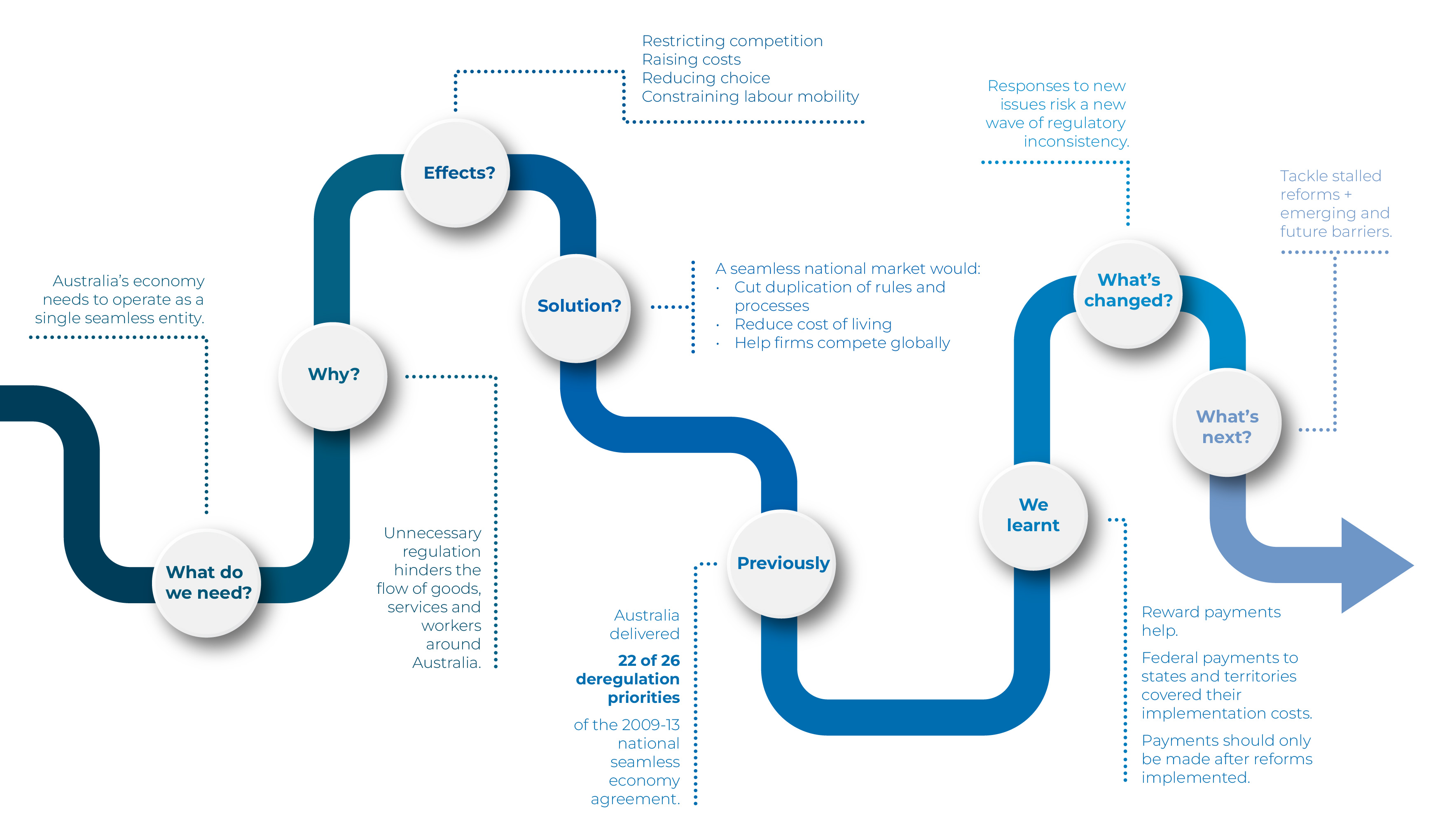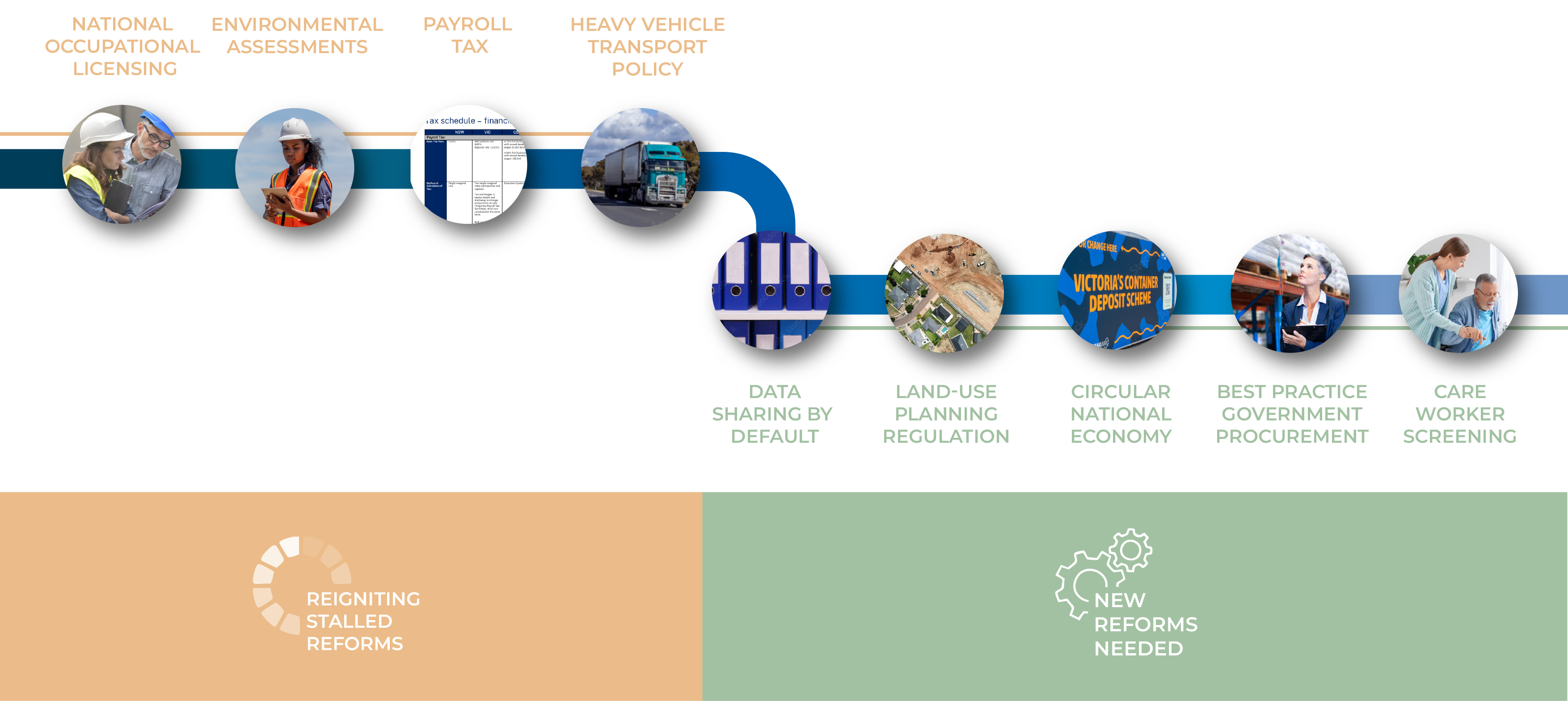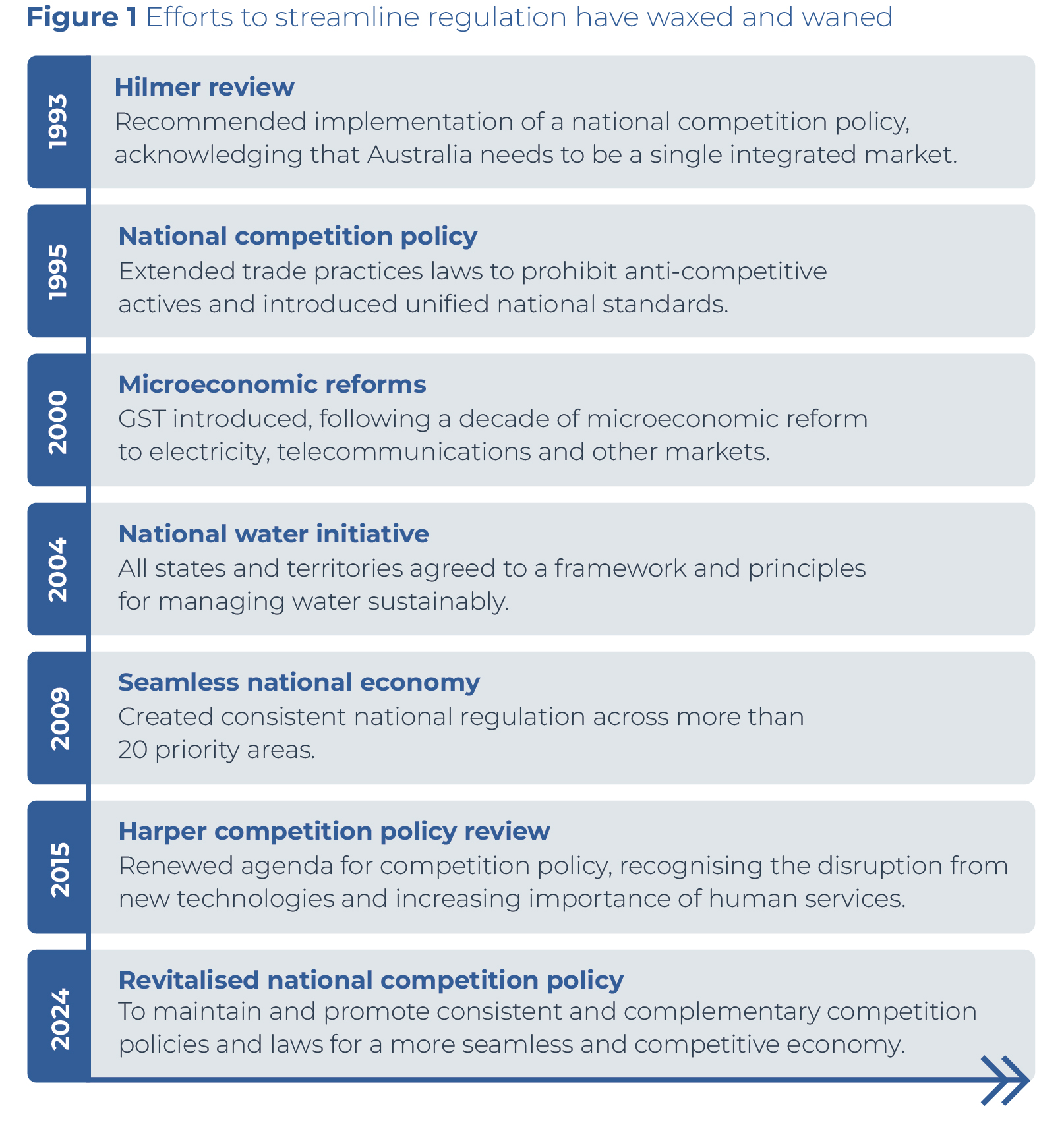Explore our Climate and Energy Hub
Towards a more seamless Australian economy makes the case for a sustained commitment to better regulation and harmonisation across Australia. It recommends a new seamless national economy agreement between the Federal Government and states and territories, identifying priority areas for reform and key steps to ensure success. This report contributes to the productivity, investment and innovation focus area of CEDA’s Progress 2050 vision for a better future for the next generation of Australians.
RECOMMENDATION
Deliver a new seamless national economy agreement between the Commonwealth and states and territories, building on the 2024 agreement to revitalise National Competition Policy. Payments to states and territories should occur after reforms are implemented.
Starting points should include:
• National occupation licensing
• Harmonised and efficient environmental assessments
• Payroll tax harmonisation
• More consistent heavy vehicle access and design rules
• Data sharing across jurisdictions by default
• More streamlined and consistent land-use planning regulation
• Consistent materials standards and registration processes to enable a more circular national economy
• Reforms to state and local government procurement to get the best offers in Australia
• Delivery of national care worker screening.
TOWARDS A MORE SEAMLESS AUSTRALIAN ECONOMY

REPORT HIGHLIGHTS
The Australian economy is facing major headwinds. Productivity growth – the key long-term driver of improved living standards – has slowed, measures of global trade uncertainty are at record highs, Australia is struggling to build enough homes to meet its housing shortage and the energy transition is proceeding too slowly.
To navigate these challenges, Australia’s economy needs to operate as a single seamless entity.
A well-functioning federation allows tailoring of policy to local conditions. It also enables innovation through learning from different approaches. Yet for too long, unnecessary regulatory barriers have hindered the flow of goods, services and workers around Australia.
Take the different widths of railway lines laid across the country in the 1800s. This was flagged as a problem before Federation, but took a century and a major Commonwealth-State investment project to resolve.
While they may not always be so obvious, frictions that prevent firms from operating seamlessly across Australia restrict competition, raise costs, reduce choice and constrain labour mobility. Anything that creates such friction without adding value holds back economic dynamism and productivity.
A single, seamless national market would cut duplication of regulation and processes, reducing the cost of living and helping firms compete internationally. Reducing barriers to people moving to better jobs can also boost productivity by better matching skills to jobs. To enable this, reform must occur across many sectors and activities.
Australia has worked across levels of government to develop nationally consistent policy in the past and can do so again. In this report we focus on the lessons learned from the National Partnership Agreement to Deliver a Seamless National Economy in effect between 2009 and 2013. These reforms were estimated to deliver over $6 billion in annual benefits to the economy. Unfinished reforms offer a similar magnitude of benefits.
Yet a new seamless economy agenda is about much more than just completing unfinished business. The economy has changed considerably in the past 15 years. The care sector accounts for a growing share of employment. In an increasingly inter-dependent, digital and service-based economy, constraints on operating and sharing data across borders have become even more damaging. Better data-sharing alone could boost Australia’s economy by up to $10 billion.
Meanwhile, responses to new issues, such as electric vehicles, gig work and container recycling schemes, risk a new wave of regulatory inconsistency.
Internationally, Canada has already taken action, striking agreements to increase domestic integration in response to US tariffs. It is a federation like Australia, but with much larger barriers to inter-jurisdictional trade.
We may no longer be laying down incompatible rail lines, but inconsistencies in how we regulate today’s new technologies may eventually be seen in the same light. Australia should smooth the frictions in its economy to ensure it can navigate the challenges ahead.
THE ORIGINAL SEAMLESS NATIONAL ECONOMY AGENDA
The National Partnership Agreement to Deliver a Seamless National Economy between the Commonwealth Government and the states and territories was in effect between February 2009 and June 2013. The agreement contained 27 deregulation priorities and eight priority areas for competition reform.
It sought to reduce the level of unnecessary and inconsistent regulation across jurisdictions, deliver agreed deregulation and competition reforms, and improve processes for making and reviewing regulation. It delivered considerable benefits to the economy.
The agreement came after a hiatus in market reforms through the early part of this century, following the drive towards a single national market that had started with the 1993 Hilmer inquiry into a national competition policy (Figure 1).
Considerable progress was made on 22 of the 27 deregulation priorities, including important reforms to deliver a single Australian Consumer Law, the National Construction Code, a national consumer credit regulation framework and a single national personal property securities register.
These reforms had substantial payoffs for relatively little cost. The Productivity Commission (PC) estimated that the deregulation priorities could cut costs for businesses by $4 billion per year and boost GDP by $6 billion per year. This was based on full implementation of 17 of the 27 reforms where the policy process was either complete or largely complete as of 2012.
Further progress on reforms to maritime safety, electronic conveyancing and business names delivered additional benefits of around $250 million per year.
Less progress was made on the eight priority areas for competition reform. This was in part due to their complex and challenging nature, but also due to a lack of government commitment after the Global Financial Crisis.
Overall, the first quarter of this century has seen a lack of commitment to pro-competition policies and a nationally open market. This has coincided with, and contributed to, the collapse in productivity growth in Australia.
A small set of initiatives were put forward late last year under the revitalised National Competition Policy, which provides a framework to promote consistent competition policies. We can build on this framework to achieve a more seamless and competitive economy.
KEY STEPS TO ENSURE SUCCESS
Lessons we can take from the original seamless economy reforms to ensure a new agenda is similarly successful include:
• Central government departments responsible for driving reform:
The agreement was led by the Prime Minister, premiers and chief ministers and their departments, giving the reforms support from the top levels of government.
• States and territories should be paid to implement the priorities:
Federal funding of $550 million for states and territories over five years was critical to success. Compared with the multi-billion-dollar benefits of the reforms, it was a relatively small spend. The payments helped by covering immediate implementation costs, which can otherwise be a barrier where the longer-term fiscal benefits flow primarily to the Commonwealth. Payments also helped to boost the case for reform, as ministers choosing not to proceed could be asked to find equivalent cost savings elsewhere in their portfolio. There were no payments for the competition reforms, contributing to a lack of progress on these reforms. In total, governments completed 21 of 26 reforms with reward payments attached, but just 10 of 19 reforms without payments.
• Implementation should be independently assessed and verified:
The COAG Reform Council played a critical role in assessing progress on reform. Payments to states and territories were linked to these assessments. The exception was Victoria, which was not penalised for failing to fully implement all reforms because the Commonwealth transferred $55.1 million in payments to Victorian Local Hospital Networks in 2012-13. Payment should only be made after states and territories implement reforms.
• First develop the evidence base and case for change:
The long list of deregulation and competition reforms under the seamless economy agenda drew from research over many years from bodies such as the PC. Conversely, for some topics such as chemicals and plastics regulation, anti-dumping and parallel importation of books, reviews were commissioned but many key recommendations were not implemented before the agreement concluded in 2013.
PRIORITIES FOR A NEW ROUND OF REFORM
The 2024 National Competition Policy agreement provides a framework to advance reforms to deliver a single national economy. The priorities we have identified are based on the scale of potential benefits as well as the difficulty of implementation of each change.
Using this approach, two of five unfinished seamless national economy deregulation reforms on occupational licensing and environmental assessment merit a renewed effort, and further payroll tax reforms are also needed. Some other partially implemented reforms – such as changes to the anti-dumping system – could be progressed by the Federal Government alone.
Other areas where collaboration is critical, such as health and energy, are better pursued through industry-specific forums such as the Health Ministers Meeting, National Energy Transformation Partnership and the Energy and Climate Change Ministerial Council. Including energy reforms in the original seamless economy agenda did not help advance progress by the COAG Energy Council and other energy-specific bodies. Reform to improve harmonisation, for example in licensing, environmental assessments and data sharing, can nonetheless play an important complementary role to sector-specific initiatives.
REIGNITING STALLED REFORMS AND REFORMS TO ADDRESS NEW FRAGMENTATION
Emerging issues have raised new inconsistencies in regulation across states and territories.
Service and installation rules for electric vehicle chargers were developed inconsistently across jurisdictions, and connection processes for high-power chargers also vary. This inconsistency has become increasingly important over the past five years as electric vehicles have gone from less than 1 per cent of light vehicle sales to more than 10 per cent. While connections reforms should be progressed in energy forums, as noted below there is also a need to harmonise approaches to end-of-life for electric vehicle batteries.
The rise of the gig economy, mentioned above in relation to payroll tax inconsistencies, has also driven new areas of duplication on workplace
relations, where federal and state legislation (for example, provisions for courier drivers in Queensland’s Industrial Relations and Other Legislation Amendment Bill 2022) both cover minimum pay and conditions.
These emerging issues raise a tension between enabling governments to take different approaches to new challenges and learn from each other, and harmonised approaches that prevent unnecessary differences and frictions between jurisdictions.
A pragmatic approach would enable innovative approaches in different states but converge to a harmonised regime within a few years. This means it is now time for convergence on the key issues outlined below. All new regulation should consider what is happening in other jurisdictions to avoid unnecessary inconsistencies.

CONCLUSIONS
Australia must enhance the mobility of workers, firms, products and capital across the economy to respond effectively to the challenges and opportunities we face. Where our regulatory systems are conflicting and fragmented across states and territories, these frictions make it difficult for productive businesses to start up and expand nationally. This is costly and burdensome, and prevents Australian businesses from being among the most competitive and dynamic in the world.
Fortunately, there is a template for success. Australia delivered billions of dollars from higher productivity growth through the seamless national economy agenda between 2009 and 2013. While not all reforms were delivered, considerable progress was made on 22 of 27 deregulation priorities. These changes have stood the test of time and continue to deliver benefits.
Some unfinished business should be prioritised in a new round of reform:
• Occupational licensing, building on national occupational licensing for electricians announced in early 2025;
• Harmonised and efficient environmental assessments;
• Payroll tax harmonisation; and
• More consistent heavy vehicle access and design rules.
But this is about far more than unfinished business. A more seamless approach to emerging issues would deliver benefits critical to Australia’s success in the energy transition, tackling its housing crisis, digital transformation and artificial intelligence, and increasing demands on the care sector. Priority areas include:
• Data sharing across jurisdictions by default;
• More streamlined and consistent land-use planning regulation;
• Consistent materials standards and registration processes to enable a more circular national economy;
• Reforms to state and local government procurement to get the best offers in Australia; and
• Delivery of national care-worker screening.
Key lessons from the first seamless economy agenda should be incorporated into a new agreement. These include first developing the evidence base and case for change, as well as having central agencies driving progress. Payments from the Australian Government to the states and territories, following independent verification of implementation, are also important to overcome implementation challenges.
The National Competition Policy framework agreed by Treasurers in late 2024 might provide a framework to progress seamless national economy reforms. It includes public commitment to a single national market from jurisdictions, modelling by the PC to inform priorities, assessment of implementation by the National Competition Council, and payments upon successful implementation.
However, the scale of funding needed to progress these reforms is likely to exceed the $900 million available under the Federal Government’s new National Productivity Fund. Reform to occupational licensing alone is likely to require hundreds of millions of dollars to smooth the path for state and territory regulators.
In prioritising reforms, it is important not only to focus on potential economic benefits but also on implementation challenges and how to overcome them. This includes considering the number of stakeholders required to reach agreement, the complexity of institutional reforms, the time needed for communication and consultation, and mechanisms to compensate those adversely affected.
A reinvigorated seamless approach won’t solve all the issues in Commonwealth-State relations. There is need for further review and reform, industry-specific collaboration in key sectors such as energy and health, and a whole-of-Federation approach to addressing growing pressures on service provision, complexity in delivery and budget sustainability.
A sustained commitment to better regulation and harmonisation can deliver achievable, evidence-based reforms that will reduce friction in the economy and ultimately help lift Australia’s productivity growth.
Author
Andrew Barker
Head of Research

